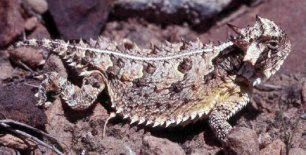|
| Query: Common toad | Result: 76th of 127 | |
Texas Horned Lizard (Phrynosoma cornutum) - Wiki
| Subject: | Texas Horned Lizard (Phrynosoma cornutum) - Wiki
| |

| Resolution: 306x155
File Size: 19778 Bytes
Upload Date: 2007:09:19 17:20:17
|
Texas horned lizard
From Wikipedia, the free encyclopedia
The Texas horned lizard (Phrynosoma cornutum) is one of 14 North American species of spikey-bodied reptiles called horned lizards. The Texas species ranges from Colorado and Kansas to northern Mexico, and from southeastern Arizona to Louisiana and Arkansas. Texas is the heart of its range. There are also isolated, introduced populations in the Carolinas, Georgia, and northern Florida.
The horned lizard is popularly called a "horned toad," "horny toad", or "horned frog," but it is neither a toad nor a frog. The popular names come from the lizard's rounded body and blunt snout, which give it a decidedly toad-like or frog-like appearance. (Phrynosoma literally means "toad-bodied." Cornutum means "horned.") The lizard's horns are extensions of its cranium and are composed of true bone.
The Texas horned lizard is the largest-bodied and most widely distributed of 8 species in the United States. It grows to a maximum length of 4-6 inches. Although its coloration generally serves as camouflage against predation, when threatened by a predator, a horned lizard puffs up its body to cause its spiny scales to protrude, making it difficult to swallow. The Texas horned lizard, along with at least three other species, also has the ability to squirt an aimed stream of blood from the corners of the eyes for a distance of up to 5 feet. This not only confuses would-be predators, the blood is mixed with a chemical that is foul-tasting to canidae predators such as wolves, coyotes, and domestic dogs.
About 70% of the Texas horned lizard's diet is made up of harvester ants, though they supplement these with termites, beetles, and grasshoppers. In recent years, the Texas horned lizard has declined in about 30% of its range, though there is some indication it may be making a comeback. The decline is usually blamed on overuse of pesticides and the spread of non-native, but highly aggressive and fiercely territorial, Brazilian fire ants. Both eradicate harvester ant colonies, destroying the horned lizard's principal source of food. The Texas horned lizard is now a protected species and it is illegal to take, possess, transport or sell them without a special permit.
Some Native American peoples regarded horned lizards as sacred. The animal is a common motif in the art of many Native Americans in the Southwestern U.S. and in Mexico.
The horned lizard is the state reptile of Texas and, as the "horned frog", is the mascot of Texas Christian University (TCU).
http://en.wikipedia.org/wiki/Texas_horned_lizard
| The text in this page is based on the copyrighted Wikipedia article shown in above URL. It is used under the GNU Free Documentation License. You may redistribute it, verbatim or modified, providing that you comply with the terms of the GFDL. |
|
Comments |
|---|
| | Guest |
|
Scientific Name: Phrynosoma cornutum (Harlan, 1825)
Common Names: Texas Horned Lizard, [German] Texas-Krötenechse, [Spanish] Lagartija-cornuda texana
Synonyms: Agama cornuta Harlan, 1825 |
^o^
Animal Pictures Archive for smart phones
^o^
|
|
|